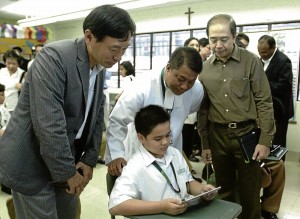La Salle Green Hills classrooms go high-tech

TEACHER May Buenaobra and her fifth grade honors class at LSGH go digital with Samsung e-board and tablets. Photo by RODEL ROTONI
A teacher conducting a class with a touchscreen board and students using digital tablets as textbook, notebook or test pad may seem like a scene in a futuristic movie, but it is a reality now.
The even bigger surprise is that it is happening right here.
La Salle Green Hills (LSGH) has partnered with Samsung Electronics Philippines Corp. (Sepco) to turn old classrooms into high-technology zones.
Tech-savvy fifth graders of LSGH’s star section demonstrated electronic learning using a digital personal learning device, nicknamed Pearl, and an electronic board or e-board. Anequally tech-savvy teacher facilitated the demonstration.
The class started with a presentation of the homework of the students, who had been asked to research on Filipino Christmas traditions online. One student reported on holiday table fare, for instance.
Article continues after this advertisementA video presentation, “A Social Network Christmas,” then a discussion using a story map that asked five questions about the video’s content, followed.
Article continues after this advertisement“Do you know where Bethlehem is?” asked teacher May. She then accessed Google Maps to show the exact location of Jesus’ birth town.
After the discussion, the students had to answer a ten-item quiz. Questions were flashed on the e-board and the students answered using their Pearl. With answers electronically evaluated, scores were immediately known and, almost instantaneously, parents got the results through e-mail.

TO SHARE his research on Christmas traditions with the class, a student uses the e-board. Photo by RODEL ROTONI
Pioneering
“The LSGH students will be the first in the country’s basic education community to use the tablet PC as a personal learning device. Sepco and the LSGH administration believe this will prepare them well for life in an increasingly information-based economy and an electronically networked society,” said LSGH information technology consultant Jun Lozada, an electronics engineer by training.
Lozada, who initiated the Pearl project, said the idea came to him while he was in hiding because of death threats arising from corruption cases against the previous administration.
To make good use of so much free time, he thought of improving the learning condition of students at LSGH. He noticed that many students carried heavy bags to school.
When the condition of his daughter, who suffers from scoliosis, worsened because of her heavy bag, Lozado looked more seriously into the feasibility of replacing printed textbooks and notebooks with the e-tablet, which was already an emerging technology.
But first, Lozada had to sell his idea to teachers and administrators. Eventually, a roadmap was set for the Pearl project.
The first phase involved the conversion of textbooks to e-books. Then assignment notebooks and other school communications were replaced. A system was set up for the use of e-tablets in presentations and other school work, and vis-à-vis other technologies and systems of learning. Finally, new learning content and strategies were created.
Still in its pilot phase, the project is being implemented first in the star sections of all levels in both grade school and high school at LSGH.

TO SHARE his research on Christmas traditions with the class, a student uses the e-board. Photo by RODEL ROTONI
Lozada said this would allow students and teachers “to explore and experience the e-tablet as a new medium for learning.” He
added this would also give parents a chance to understand and participate in the use of technology in education.
For the Pearl project, LSGH and Sepco made available the latest tablet PC to participating students and teachers at discounted prices.
The Pearl project, while helping ease the lives of students by making their bags lighter, also aims “to introduce the ‘digital word’ as a new medium of communication in addition to the traditional spoken, written and printed word,” Lozada said.
As LSGH president Bro. Felipe Belleza, FSC, said, in today’s generation, the digital word was the new vernacular.
Believed to be a pioneering move in global education, the Pearl project also makes history by using some teaching applications made by Filipino computer programmers and application developers.
“Sepco believes that the Pearl project is a great contribution to the advancement of Philippine education into the digital information era,” said Sepco president KC Park. “It will foster the creation of new learning systems and methods in introducing the digital word as the new medium of communication in the classroom and beyond.”